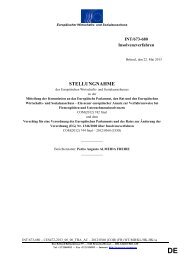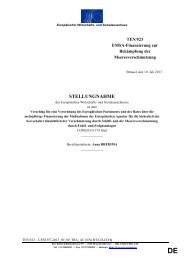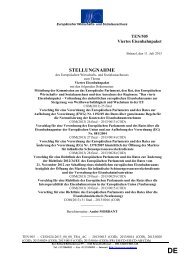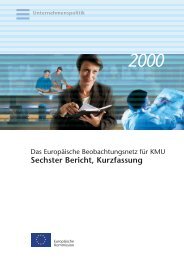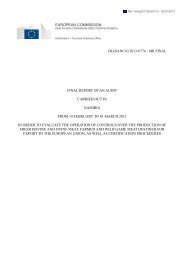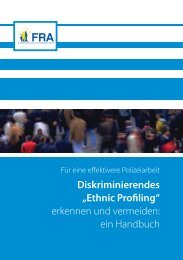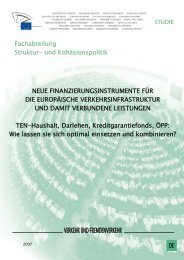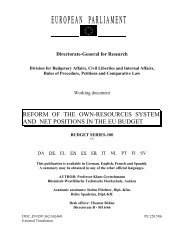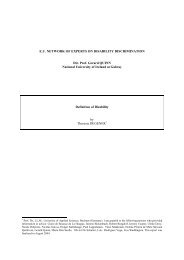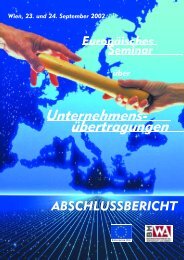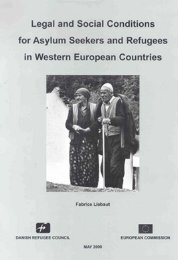Bulgaria - The social impact of seasonal migration
Bulgaria - The social impact of seasonal migration
Bulgaria - The social impact of seasonal migration
You also want an ePaper? Increase the reach of your titles
YUMPU automatically turns print PDFs into web optimized ePapers that Google loves.
44<br />
irregular <strong>Bulgaria</strong>n migrants in the Netherlands, 80% are ethnic Turks, most <strong>of</strong> them<br />
coming from the South-eastern <strong>Bulgaria</strong>n district <strong>of</strong> Kurdzhali, 10% Roma and 10 %<br />
<strong>Bulgaria</strong>ns (interview No. 15).<br />
3.1.3. Irregular <strong>migration</strong>, including trafficking and smuggling in human beings<br />
Trafficking and smuggling in human beings is another aspect <strong>of</strong> irregular <strong>migration</strong>. <strong>The</strong><br />
department <strong>of</strong> illegal trafficking <strong>of</strong> <strong>Bulgaria</strong>n citizens at the National Office <strong>of</strong> Border<br />
Police, created in December 1999, is fighting with the traffic <strong>of</strong> <strong>Bulgaria</strong>ns abroad, and<br />
especially, <strong>of</strong> women. One can only indirectly account for the number <strong>of</strong> <strong>Bulgaria</strong>n<br />
women trafficked abroad, i.e. through the number <strong>of</strong> deported women <strong>Bulgaria</strong>n<br />
citizens, although it will always be smaller than the real number <strong>of</strong> the victims <strong>of</strong> traffic.<br />
According to the head <strong>of</strong> department, there is a tendency towards raising the number <strong>of</strong><br />
<strong>Bulgaria</strong>n women deported from abroad and decreasing the number <strong>of</strong> women non-<br />
<strong>Bulgaria</strong>n citizens expelled from <strong>Bulgaria</strong>.<br />
<strong>The</strong> traffic in women non-<strong>Bulgaria</strong>n citizens - chiefly from Russia, Moldova and Ukraine<br />
- was drastically reduced after successful police actions against traffic organisers, among<br />
whom were some <strong>Bulgaria</strong>n border guards and Romanian policemen. Instrumental in<br />
the struggle against the illegal traffic <strong>of</strong> Russian and Ukrainian women through <strong>Bulgaria</strong><br />
was the imposition <strong>of</strong> visa requirements for Russian and Ukrainian citizens in October<br />
2001, which was one <strong>of</strong> the measures for harmonisation <strong>of</strong> the <strong>Bulgaria</strong>n visa regime<br />
with that <strong>of</strong> the EU. <strong>The</strong> introduction <strong>of</strong> these visa restrictions resulted in effectively<br />
curtailing the illegal traffic in women from these countries. <strong>The</strong> direction <strong>of</strong> human<br />
traffic from <strong>Bulgaria</strong> underwent transformations as well. While until 2000 women were<br />
trafficked primarily to Greece, after 2000 the flows were oriented to Western Europe,<br />
mainly to France and Belgium, now to Spain and Holland, too (interview No. 4).<br />
<strong>The</strong> reasons for the traffic are above all economic. <strong>The</strong> majority <strong>of</strong> the <strong>Bulgaria</strong>n women<br />
victims <strong>of</strong> traffic come from North-eastern <strong>Bulgaria</strong> - from the regions <strong>of</strong> Dobrich,<br />
Isperih, Turgovishte, Razgrad - where unemployment and the lack <strong>of</strong> prospects are<br />
hitting the young people especially badly. Border police experts have detected a<br />
"geographic specialisation" among <strong>Bulgaria</strong>n traffic organisers. Traffickers from<br />
Pazardzhik export women to Belgium and Holland, those from Sliven send the women<br />
to France. Traffic organisers from North-eastern <strong>Bulgaria</strong> have recently found a new<br />
destination in Poland, while Greece is targeted by traffickers from Petrich, in the Southwest,<br />
because <strong>of</strong> the geographic proximity (interview No. 4). <strong>The</strong>re are single cases <strong>of</strong><br />
villages (around Sliven) with a chain <strong>migration</strong> abroad <strong>of</strong> women victims <strong>of</strong> traffic<br />
(interview No. 11).<br />
Since the victims are, as a rule, <strong>of</strong> lower education and their age is falling - there are even<br />
14-16 year old girls among them - they are not in a position to evaluate appropriately the<br />
risks behind finding employment abroad. Many <strong>of</strong> them are tempted by vague promises,<br />
others are cheated right away. Those who have become victims <strong>of</strong> fraud are the first to<br />
return: they do succeed to escape within 2-3 or maximum 6 months. Some <strong>of</strong> them are<br />
placed in shelters, managed by inter- and non-governmental organisations such as IOM,<br />
Nadia Centre, Animus Foundation, etc. Despite that the anonymity <strong>of</strong> the capital attracts<br />
returned victims <strong>of</strong> traffic to stay in S<strong>of</strong>ia, non-governmental experts recommend that<br />
they return to their home places and use the extended network <strong>of</strong> their family and<br />
relatives in order to re-integrate faster into society. In 1998, Nadia Centre hosted 9<br />
victims <strong>of</strong> traffic in its shelter, in 1999 - 1, in 2000 - 3, in 2001 - 3, and in 2002 - 17 (but has



